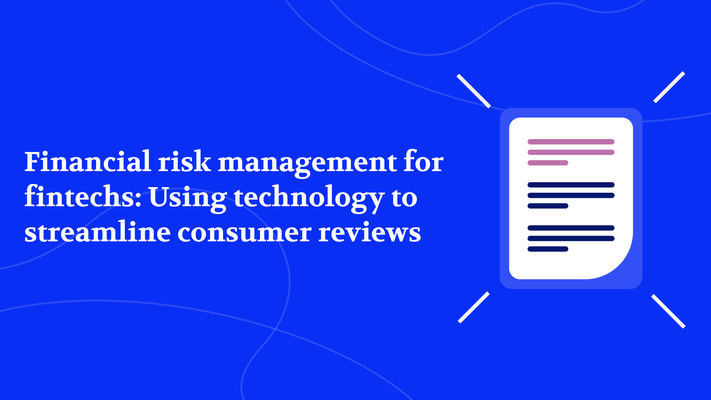Financial risk management is a crucial aspect of business growth, especially for young budding fintech companies who seek to satisfy the essential balance between maximising revenue whilst minimising costs during an economic downturn. Risk management, when executed properly, should ensure stability, reduce customer friction, mitigate the potential for revenue loss, protect against fraud and also protect consumers by reducing the likelihood of their own financial harm or loss.
This article explains which key areas financial startups who operate in the credit and consumer loan space should focus on when it comes to building an efficient risk management framework, including the automation of manual loan reviews, operations processes, and compliance.
Consumer Loan Reviews
It may seem quite simple to state, but the success of any financier looking to lend consumers large amounts of credit or cash hinges on the thoroughness and efficiency of the review process. Assessing the creditworthiness of potential borrowers is not a new phenomenon. However, banks, lenders, and fintechs have adapted to newly available technologies at different speeds and it seems to be the latter most dedicated to finding technology-driven ways to make the creditworthiness examinations as streamlined and cost-effective as possible.
By using data and affordability trends provided by technology providers like Homeppl, the gathering and analysing of better, more precise, information about a borrower's financial history and current circumstances means fintechs can make more informed decisions about whether to approve a loan application and what terms to offer.
Consumer loan reviews typically include a variety of information, such as credit scores, employment and income information, and other financial data. The problem with standard UK credit checks delivered by Credit Reference Agencies (CRAs) is that they tend to fail applicants who have a more complex stream of income, or who are ‘thin-filed’, as well as perhaps internationals or applicants with no UK credit history at all. They essentially deny financial access to a stream of new customers.
Consumer loan reviews conducted by fintechs who use Homeppl’s financial data enrichment technology paint a much more accurate picture of consumer risk and affordability as a combination of data points, collected from consumers through their applications, are plugged into our algorithms for precision and additional context. By analyzing this information, loan providers can assess a borrower's ability to repay and identify any potential risks.
For example, a traditional CRA check may tell you that a low credit score may indicate a higher risk of default. The true situation could be the applicant is a financially viable consumer, with low risk, who can afford a loan, and just hasn't taken out a credit card in the UK yet. Fintechs would have gained a customer whereas more traditional lenders would not. Revenue-generating, value-adding information at work.
Actionable intelligence for fintechs
So what sort of consumer data can be added to build a more accurate risk profile for fintechs or lenders?
Financial data enrichment offers a methodology that allows loan reviewers to make decisions based on a number of alternative data trends.
Why look at three months of bank statements and manually wade through hundreds of transactions, trying to decipher the charge amount and title when you could use automated financial analysis to achieve clearer results in seconds? On average, ops and risk teams can waste up to 200 hours per week manually going through applications. Not only can review software offer better data trends but the automation can mitigate human error by adding up calculations, checking spelling mistakes and searching for any other document infrastructure anomalies.

Once a bank statement has been analysed by Homeppl’s enrichment tool, instant graphs, groups and affordability modelling is broken down into an actionable report. This financial risk management tool allows you to discover:
Consumer spending habits
Overdraft usage
Affordability threshold
Debt repayments
Income vs expenditure trends
A combination of alternative date sources
How else can fintechs benefit from data enrichment? By using mobile phone data, e-commerce purchase records, publicly available company information, social media presence and other digital data, to build a more complete picture of the borrower and make more accurate lending decisions.
Furthermore, consumer loan reviews can help fintechs identify and prevent fraud, which is a significant risk in the lending industry. By verifying the information provided by borrowers and checking for red flags, such as false identities, fake documents, misleading or false financial, employer or residential information, or providing multiple loan applications, fintechs can help protect themselves and their customers from fraud.
We at Homeppl have seen that up to 10% of consumer applications can contain some level of fraud. This can cost lenders and young financial startups millions in damages and legal fees.
Fraud Finder, Homeppl’s financial risk management software for fraud can easily identify when any financial document has been modified to present false information.
Our full check goes a step further, building a full consumer risk profile on each applicant, and checking for fraud in every single aspect of an application. Each consumer undergoes 150+ fraud tests.
Operational efficiencies in fintechs
Operations processes are another important area for fintechs to focus on when it comes to financial risk management. This includes everything from how loans are originated and underwritten, to how they are serviced and managed over time. By streamlining and improving these processes, fintechs can reduce the risk of errors or mistakes that could lead to financial losses. This can be achieved through the use of technology, such as automated underwriting systems, and by implementing robust internal controls and procedures.
While it may appear that Fintech companies, not having physical branches to manage, have an advantage over traditional financial institutions, they may face different challenges in reality when it comes to operational resilience and efficiency.
For instance, traditional firms have the option of directing their customers to their physical branches in case of failure of online services, but Fintechs do not have that luxury. Additionally, during crisis situations, established companies may have access to a wider range of resources, such as compliance and risk expertise, that Fintechs may not possess.
The pandemic has also highlighted the shortcomings of risk management models that rely heavily on manual processes such as spreadsheets, email and shared drives, in terms of operational resilience. So much efficiency can be lost to manual work and creates unnecessary costs and friction that automation can fix.
So how exactly does automation save operational costs for fintechs?
Firstly, creating more efficiency in risk management through automation does not come from turning all tasks over to machines. It’s more about automation of tedious tasks that can waste so much time, and re-allocate the time of the ops team towards something more productive.
Searching for and verifying account information
Operations analysts can spend hours filtering through email threads or different G-drive to find critically important information, or spend time extracting or cross-examining information between different tools and systems. Once humans start performing these tasks at scale, mistakes are inevitable.
Transferring and checking bank statement balances or account holder information and sort codes may be achievable manually three or four times in a hour without mistakes, but once you’re dealing with a larger amount of applications to review, this becomes more problematic. That one erroneous balance calculation can either grant or deny financial access to a consumer, and may as a result, put the business at risk.
Bank statement extraction software and information extraction tools are now available to fintechs to leave those tedious tasks to machines, whils ops executives can focus on making other process flows more efficient. As fintechs often collect and process sensitive financial data, it is essential that they have robust security measures in place to protect this information from unauthorised access or breaches. This can help to reduce the risk of financial fraud and protect the reputation of the business.
Compliance
Compliance is also a key concern for fintechs, as they must adhere to a wide range of regulations and requirements in order to operate. This includes laws and regulations related to consumer protection, money laundering, and financial crime. By maintaining a strong compliance program and staying up-to-date with the latest regulatory developments, fintechs can reduce the risk of regulatory violations and potential fines.

Having strong and effective know-your-customer (KYC) standards is crucial for risk management in the financial services sector. Banks and fintechs that lack sufficient KYC facilities may face a variety of risks including legal and reputational harm. Not only do sound KYC policies and procedures aid stability and general well-being, they also secure the reputation and integrity of the banking system by reducing the chances of illegal activities such as money laundering and terrorist financing. Recent efforts to combat terrorism in particular have emphasised the significance of financiers being able to track their customers in any location where they conduct business.
Compliance regulation volatility in 2023
Fintechs and lenders have to abide by national and international regulations, and these can change almost daily in a modern world where there is a war in Ukraine and changing financial regulations and sanctions imposed on Russia. There are also new sanction laws on financing being imposed on other countries such as Iran, North Korea and Venezuela.
This infrequent pattern of sanction updating seems to be diverging from the past, when sanctions were more likely to be applied to jurisdictions in a blanketed manner. This dynamic is causing a challenge for financial services firms to maintain compliance across multiple jurisdictions and governing bodies, particularly if they are not able to adapt swiftly to the rapidly changing regulatory landscape. Manual KYC processes are still frequently used which poses greater risk of non-compliance due to internal inefficiencies that impede the speed at which regulated firms can respond to change.
To keep up with the fast-paced regulatory changes and complex environment we live in, fintechs must prioritise investing in their technological infrastructure. Implementing an efficient and cost-effective KYC process can only be achieved with tech advancements.
Homeppl’s AML checks ensure KYC and KYB regulatory compliance across jurisdictions. With the full check, income sources can be verified, fraud signals and suspicious payments activity can be flagged and manually reviewed inline with a company’s pre-conditioned and tweak-able risk appetite.
The digital age has brought new challenges and opportunities for fintech companies when it comes to financial risk management. A proper execution of risk management can ensure stability, reduce customer friction, protect against revenue loss, and safeguard consumers. By leveraging technology providers like Homeppl, fintechs can gather more accurate information about borrowers' financial history and current circumstances in order to make more informed decisions. By analysing this information, loan providers can assess a borrower's ability to repay and identify any potential risks. Overall, this not only helps to streamline the process and reduce costs but also enables fintechs to access and serve a wider range of customers whilst managing risk effectively and efficiently.
What to read next:
Financial data enrichment: What is it?
The rising threat of fraud in the insurance sector
The Top Ways Mortgage Lenders Verify Bank Statements
How KYC Assessments can be enhanced with Document Verification




